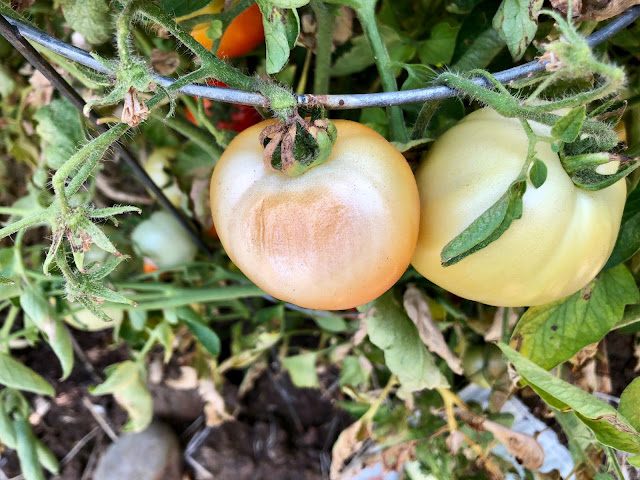
|
|
Sunburned tomatoes are among the unfortunate effects of the current heat wave. (Photo: Kathy Morrison)
|
Sacramento already has experienced its hottest day ever in August. Now, we have smoky skies, too.
What’s that doing to the zucchini and tomatoes?!
Sunday’s 112 degrees set an all-time record for August, according to the National Weather Service. That temperature may be equaled again Tuesday and Wednesday, or even surpassed. An extreme heat advisory continues through 9 p.m. Wednesday.
In addition, the revised forecast puts triple digits on every afternoon through next Tuesday, extending what already is shaping up to be a record hot streak. High temperatures have hit over 100 every day since Aug. 13. Average for mid-August: 92 degrees.
In addition, overnight temperatures have stayed very warm: 70 degrees and above. That has an effect on plants (and people), too.
Add to that record heat Sunday’s thunderstorms and lightning strikes, a rare monsoonal system weather watchers say happens once every 40 or 50 years. The storm system produced precious little rain in the Valley (0.02 inches), but started dozens of wildfires.
Smoke from those fires reduced air quality to “unhealthy” over much of the Sacramento area Tuesday. With no Delta breeze, expect those hazy skies to hang around.
Both heat and smoke will have notable effects on two of our favorite late summer crops: Squash and tomatoes.
In this weather, zucchini develop little baby squash that start out OK, but never seem to develop. It rots before it reaches 4 or 5 inches long.
The Brits call it “courgette rot,” referring to the English name for zucchini. It’s due to insufficient pollination.
While skies are smoky, bees return to the safety of their hives. They’re not out, working the squash blossoms, as they normally would do on a summer’s day.
Extreme heat further complicates bees’ lives. If temperatures top 100 degrees (as it has almost daily this month), worker bees need to bring water back to their hives, from one quart to a gallon a day. They’re too busy to pollinate.
So, female zucchini blossoms – which start forming baby squash before the bees arrive – never get the attention they need from pollinators. Without proper pollination, the squash rot before they mature. This issue can happen to other cucurbits as well such as crookneck squash and pumpkins.
In these hot and smoky conditions, tomato blossoms also will dry out and whither before forming fruit, due to that combination of excess heat and lack of pollination. Tomatoes usually will not set when temperatures are above 95 degrees.
As for eating mature squash, tomatoes, peppers, peaches, grapes and other produce that you may be harvesting, wash produce thoroughly to remove any soot from the smoke. Peel if the skin feels gritty.
What crop suffers the most from smoke? Wine grapes.
Continued exposure to wildfire smoke is of major concern to California grape growers. Grapes can absorb smoky flavors, developing what’s called smoke taint. That can ruin wine grapes; experts describe its flavor as “burnt, medicinal, campfire … like licking a wet ashtray,” according to The Wine Spectator. Often not apparent in fresh grapes, those bad flavors are brought out by fermentation.

